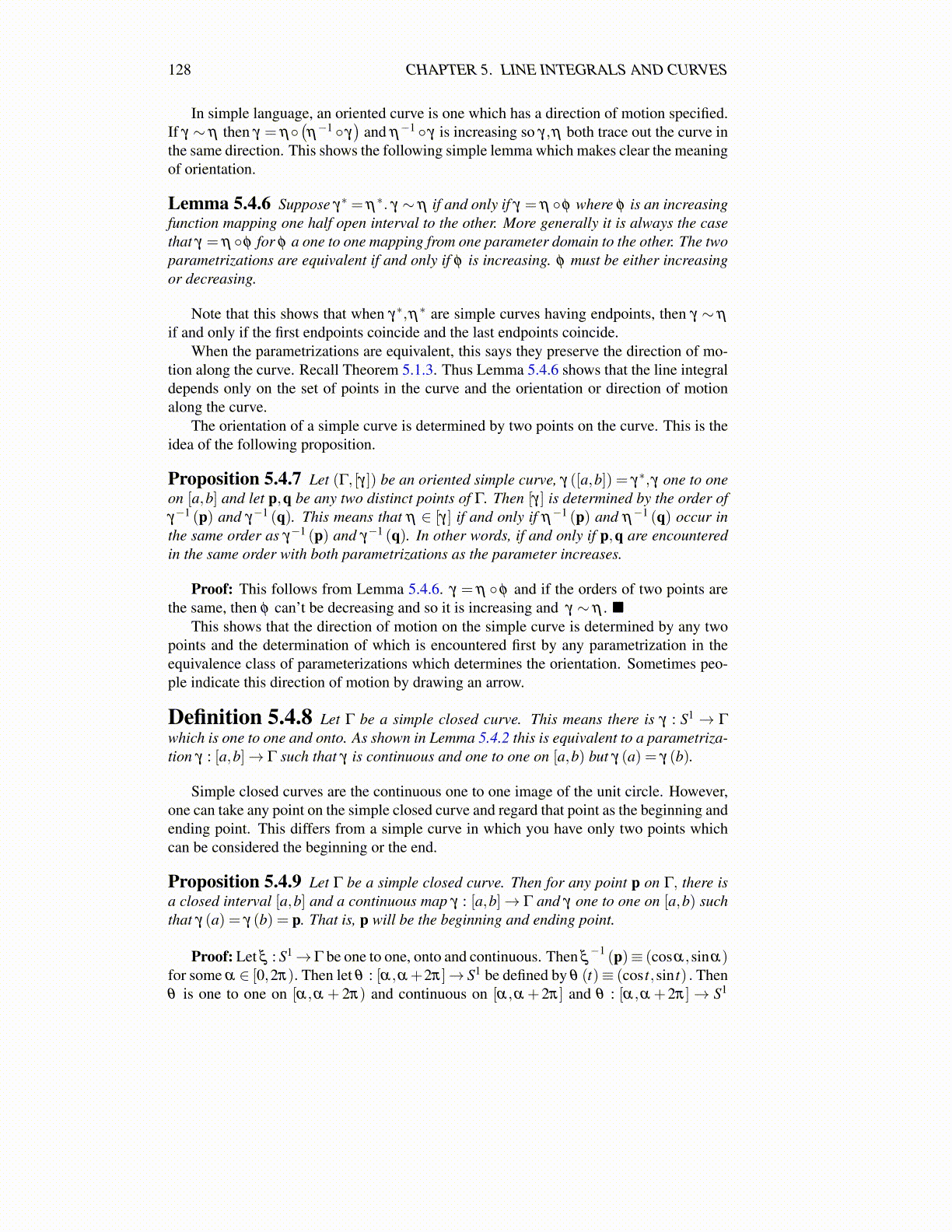
128 CHAPTER 5. LINE INTEGRALS AND CURVES
In simple language, an oriented curve is one which has a direction of motion specified.If γ ∼ η then γ = η◦
(η−1 ◦ γ
)and η−1 ◦ γ is increasing so γ,η both trace out the curve in
the same direction. This shows the following simple lemma which makes clear the meaningof orientation.
Lemma 5.4.6 Suppose γ∗ = η∗. γ ∼ η if and only if γ = η ◦φ where φ is an increasingfunction mapping one half open interval to the other. More generally it is always the casethat γ = η ◦φ for φ a one to one mapping from one parameter domain to the other. The twoparametrizations are equivalent if and only if φ is increasing. φ must be either increasingor decreasing.
Note that this shows that when γ∗,η∗ are simple curves having endpoints, then γ ∼ η
if and only if the first endpoints coincide and the last endpoints coincide.When the parametrizations are equivalent, this says they preserve the direction of mo-
tion along the curve. Recall Theorem 5.1.3. Thus Lemma 5.4.6 shows that the line integraldepends only on the set of points in the curve and the orientation or direction of motionalong the curve.
The orientation of a simple curve is determined by two points on the curve. This is theidea of the following proposition.
Proposition 5.4.7 Let (Γ, [γ]) be an oriented simple curve, γ ([a,b]) = γ∗,γ one to oneon [a,b] and let p,q be any two distinct points of Γ. Then [γ] is determined by the order ofγ−1 (p) and γ−1 (q). This means that η ∈ [γ] if and only if η−1 (p) and η−1 (q) occur inthe same order as γ−1 (p) and γ−1 (q). In other words, if and only if p,q are encounteredin the same order with both parametrizations as the parameter increases.
Proof: This follows from Lemma 5.4.6. γ = η ◦φ and if the orders of two points arethe same, then φ can’t be decreasing and so it is increasing and γ ∼ η . ■
This shows that the direction of motion on the simple curve is determined by any twopoints and the determination of which is encountered first by any parametrization in theequivalence class of parameterizations which determines the orientation. Sometimes peo-ple indicate this direction of motion by drawing an arrow.
Definition 5.4.8 Let Γ be a simple closed curve. This means there is γ : S1 → Γ
which is one to one and onto. As shown in Lemma 5.4.2 this is equivalent to a parametriza-tion γ : [a,b]→ Γ such that γ is continuous and one to one on [a,b) but γ (a) = γ (b).
Simple closed curves are the continuous one to one image of the unit circle. However,one can take any point on the simple closed curve and regard that point as the beginning andending point. This differs from a simple curve in which you have only two points whichcan be considered the beginning or the end.
Proposition 5.4.9 Let Γ be a simple closed curve. Then for any point p on Γ, there isa closed interval [a,b] and a continuous map γ : [a,b]→ Γ and γ one to one on [a,b) suchthat γ (a) = γ (b) = p. That is, p will be the beginning and ending point.
Proof: Let ξ : S1→Γ be one to one, onto and continuous. Then ξ−1 (p)≡ (cosα,sinα)
for some α ∈ [0,2π). Then let θ : [α,α+2π]→ S1 be defined by θ (t)≡ (cos t,sin t) . Thenθ is one to one on [α,α + 2π) and continuous on [α,α +2π] and θ : [α,α +2π]→ S1